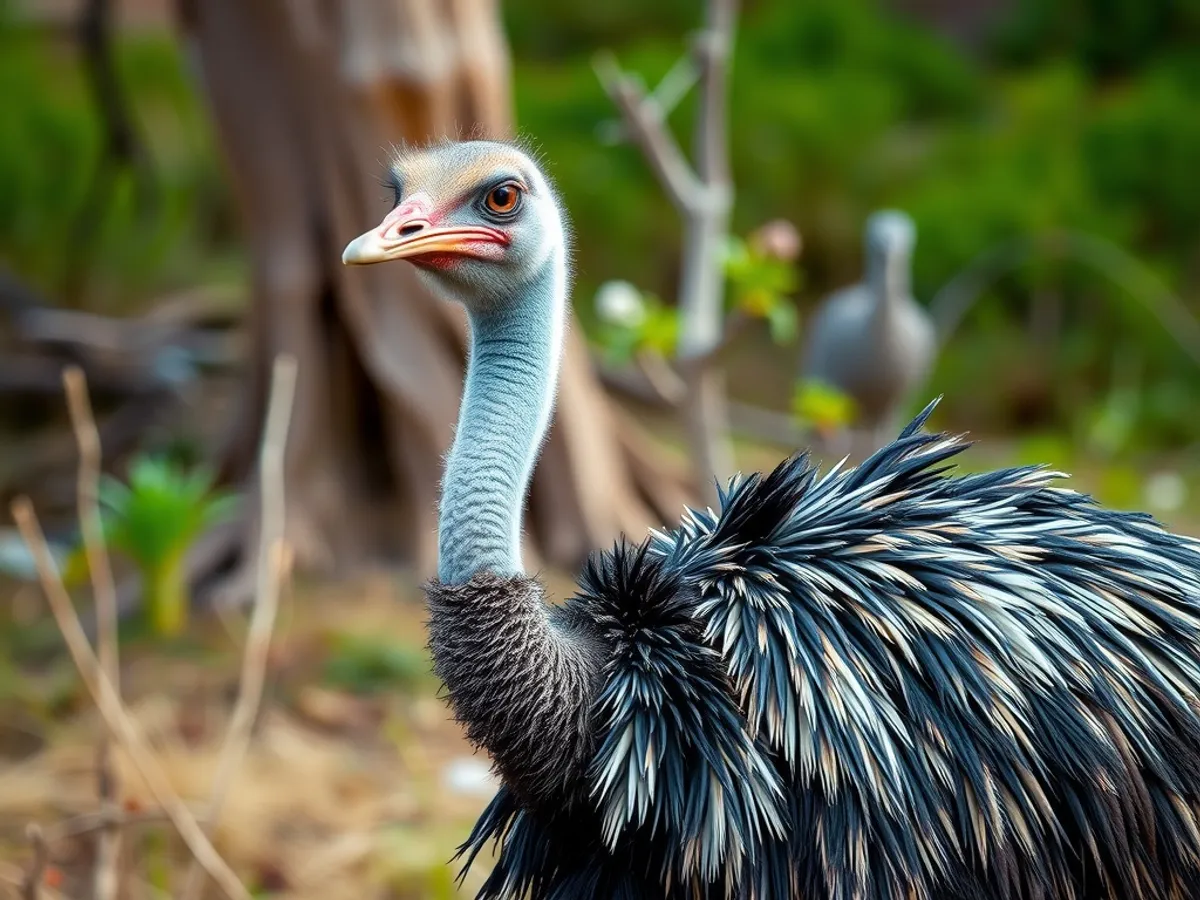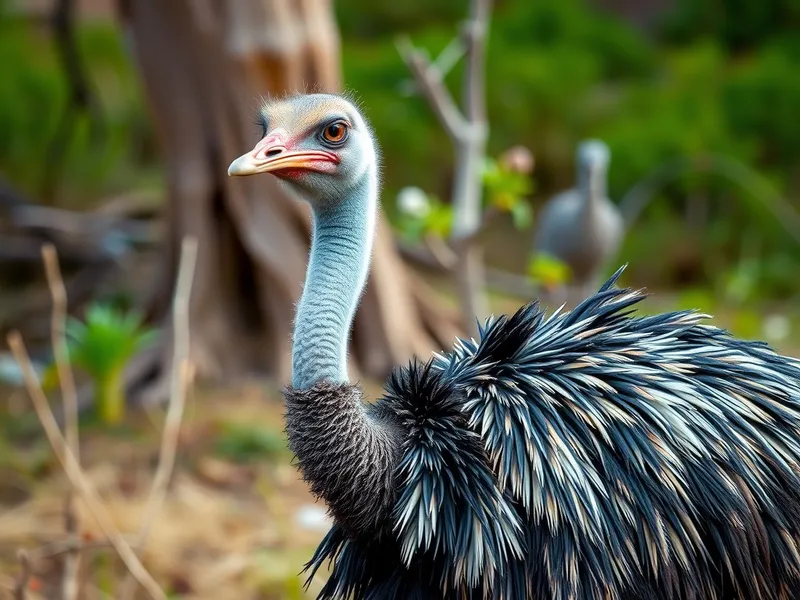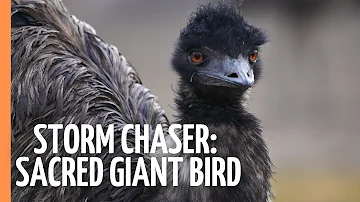
Emu
Dromaius novaehollandiae

Meet the Emu
The emu is the largest native bird in Australia and the second-largest living bird in the world, surpassed only by the ostrich. This flightless bird is characterized by its long legs, soft brown plumage, and strong, muscular body built for running. Emus can sprint at speeds up to 50 km/h (31 mph) and cover great distances in search of food. They are primarily found in a variety of Australian habitats, from open grasslands and savannas to eucalyptus forests, but avoid very dense forests and arid deserts. Emus play a significant role in Australian ecosystems by aiding seed dispersal and helping control insect populations.
Classification
Bird
Habitat
Open grasslands, savannas, and forests of Australia
Diet
Omnivore
Lifespan
10-20 years
Conservation
Least Concern
Weight
30–55 kg (66–121 lbs)
📖Fascinating Facts
Dedicated Dads
Male emus incubate the eggs for about eight weeks without eating or drinking and then care for the chicks for up to six months after they hatch.
Superb Runners
Emus can run at speeds up to 50 km/h (31 mph) and have long, powerful legs that allow them to cover large distances quickly.
Omnivorous Diet
Emus eat a wide range of foods including seeds, fruits, insects, and small animals, depending on seasonal availability.
📋Detailed Description
The emu (Dromaius novaehollandiae) is a large, flightless bird endemic to Australia, standing up to 1.9 meters (6.2 feet) tall and weighing between 30 and 55 kilograms (66–121 lbs). Its body is covered in shaggy, double-shafted brown feathers that provide insulation and camouflage, while its long, powerful legs are adapted for sustained running, enabling speeds of up to 50 km/h (31 mph). The emu's small wings, about 20 cm (8 in) long, are vestigial and used primarily for balance and thermoregulation. Emus have keen eyesight and hearing, essential for detecting predators in open habitats. Their beak is broad and soft-tipped, suited for grazing and browsing a varied diet. Socially, emus are typically solitary or found in loose flocks, but may form larger groups during migration or in response to food availability. They are nomadic, often traveling great distances to exploit seasonal food and water resources. Emus are diurnal, with most activity occurring during the cooler hours of morning and late afternoon. Their vocalizations include deep booming, drumming, and grunting sounds, produced by an inflatable throat pouch, and serve in communication and territorial displays.
💡 Did you know?
Emus have a specialized tracheal pouch that allows them to produce deep booming and drumming sounds that can be heard up to 2 kilometers away.
🔬Research & Sources
Wikipedia Summary
The emu is a species of flightless bird endemic to Australia, where it is the tallest native bird. It is the only extant member of the genus Dromaius and the third-tallest living bird after its African ratite relatives, the common ostrich and Somali ostrich. The emu's native ranges cover most of the Australian mainland. The Tasmanian, Kangaroo Island and King Island subspecies became extinct after the European settlement of Australia in 1788.
Last Modified: 5/29/2025
🎭Behavior & Social Structure
Emus are primarily herbivorous, feeding on a wide array of native and introduced plant species, including seeds, fruits, flowers, and young shoots. They also consume insects, small vertebrates, and invertebrates, especially during breeding season or when plant food is scarce. Foraging is often opportunistic, and emus have been observed following fire fronts or livestock to exploit newly available food. Emus swallow pebbles and other hard objects (gastroliths) to aid in the mechanical breakdown of food in their gizzard. They require regular access to water and are known to travel long distances to find it, sometimes covering up to 25 km (15.5 mi) in a day. Social interactions are generally peaceful outside the breeding season, though males may become territorial during nesting. Emus engage in dust bathing and sunbathing, both important for feather maintenance and parasite control. Their daily routine typically consists of alternating periods of foraging, resting, and vigilance.
👶Reproduction & Life Cycle
Emus are seasonally monogamous, with breeding occurring from April to June in southern Australia and later in the north. Courtship involves mutual displays, with females often initiating pairing by circling and vocalizing near a chosen male. After mating, the female lays a clutch of 5–15 large, dark green eggs (average size: 13 × 9 cm, weight: 450–650 g) in a ground nest constructed by the male. The male assumes sole responsibility for incubation, which lasts 48–56 days, during which he rarely leaves the nest and may lose up to one-third of his body weight. Chicks are precocial, hatching with striped down for camouflage and able to walk within hours. The male continues to guard and lead the chicks for up to 5–7 months, teaching them to forage and protecting them from predators. Emus reach sexual maturity at 18–24 months.
🛡️Adaptations & Survival
Emus possess several adaptations for survival in Australia's variable climates. Their long legs and reduced number of toes (three per foot) enhance running efficiency and maneuverability. The double-shafted feathers provide excellent insulation and help regulate body temperature, while the dark tips absorb solar radiation. The inflatable tracheal pouch, unique among birds, allows them to produce low-frequency vocalizations that carry over long distances. Emus are highly water-efficient, capable of surviving periods of drought by reducing activity and utilizing metabolic water. Their nomadic lifestyle and broad diet enable them to exploit a wide range of habitats, from semi-arid grasslands to open forests. The ability to store fat reserves in the body and the capacity for rapid fat mobilization are crucial for surviving food shortages and the energetically demanding breeding season.
🎨Cultural Significance
Emus hold significant cultural importance in Australia. They feature prominently in Aboriginal mythology, Dreamtime stories, and traditional art, often symbolizing creation, endurance, and connection to the land. The emu is one of the national symbols of Australia, appearing on the coat of arms alongside the kangaroo, and is depicted on the Australian 50-cent coin. Emu feathers, eggs, and oil have been traditionally used by Indigenous Australians for ceremonial, decorative, and medicinal purposes. The bird also plays a role in contemporary Australian identity, sports, and branding.
🔬Recent Research & Discoveries
Recent research has focused on emu movement ecology, genetic diversity, and their role in seed dispersal and ecosystem functioning. Studies using GPS tracking have revealed complex migratory patterns linked to rainfall and resource availability. Genetic analyses have clarified the relationships between extinct and extant emu populations, informing conservation strategies. Investigations into emu immune systems and physiology are contributing to understanding avian adaptation to arid environments. There is ongoing interest in the potential of emu oil for pharmaceutical applications, though clinical evidence remains limited. Fossil records indicate that emus have existed in Australia since the late Oligocene, with several extinct relatives described from subfossil remains.
🎥Wildlife Videos

Emu Dad vs The Outback: An Epic Survival Story | Full Documentary
The emu holds a special place in the myths of Australia's Aboriginal people. These giant birds were said to be creator spirits that ...
Free High-Quality Documentaries

The Emu, Australia Wildlife Animal
Wild animals attacks best attacks of wild animals wild animal fights caught on camera wild animals documentary COPYRIGHT ...
QTRR Animals

Emus in the House | Kangaroo Dundee
About Kangaroo Dundee: From his sanctuary in the bush outside Alice Springs, Brolga cares for his orphans, and spends months ...
Nat Geo Animals

Secrets of the Outback | Wild Australia in 4K | Wildlife Nature Documentary
To many, Australia's Outback seems barren and inhospitable — a vast, sun-scorched wilderness with little life to offer. But look ...
Into the Wild Films

Emu: Exploring the Fascinating World of Australia's iconic Bird
Emu Facts: Exploring the Fascinating World of Australia's iconic Bird watch full video : Did you know that the emu is one of the ...
Wildlife Pedia English

Down to Earth - Flightless Birds | Wildlife Documentary
Down to Earth - Flightless Birds - There are about 40 non-flyers around the world : The largest bird in the world lives in Africa: the ...
Travel Universe
🌍Habitat Information
The Emu typically inhabits Open grasslands, savannas, and forests of Australia environments. Emus have adapted to their environments with specialized features and behaviors.
Primary Habitat:
Open grasslands, savannas, and forests of Australia
More detailed habitat information will be available soon.
🛡️Conservation Status
The Emu is currently classified as Least Concern. Conservation efforts are crucial for preserving this species for future generations.
Common Threats:
- 🏠Habitat loss and fragmentation
- 🌡️Climate change impacts
- 🎯Hunting and poaching
- 🏭Human-wildlife conflict
⚠️Threats & Conservation Challenges
While emu populations are currently stable and classified as Least Concern by the IUCN, localized threats persist. Habitat loss due to agricultural expansion, fencing, and urban development can restrict movement and access to resources. Vehicle collisions, predation of eggs and chicks by introduced species (such as foxes and feral pigs), and droughts pose additional risks. Historical overhunting and persecution, especially in the 19th and early 20th centuries, led to the extinction of several island subspecies (e.g., Tasmanian, Kangaroo Island, King Island emus). Modern conservation challenges include balancing emu populations with agricultural interests, as emus may damage crops. However, their adaptability and wide distribution have allowed mainland populations to remain robust.
🔬Scientific Classification
Scientific Name
Dromaius novaehollandiae
Classification Hierarchy
🔍 About Taxonomic Classification
Taxonomic classification is a hierarchical system used by scientists to classify and organize living organisms based on shared characteristics and evolutionary relationships.
The system moves from broad categories (Kingdom) to increasingly specific ones, with each animal's scientific name typically consisting of its Genus and species.
📝Community Notes
Share your observations and insights about the Emu with our community of wildlife enthusiasts.
Join Our Community
Sign in to share your observations and connect with fellow wildlife enthusiasts.
Sign In to ContributeNo community notes yet
Be the first to share your observations about the Emu!
Explore Emu
Select a tab above to learn more about this amazing animal.
📸Photo Gallery
No photos available for this animal yet.
🌟Discover More Wildlife
Continue your journey of discovery with more fascinating animals from our database
